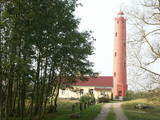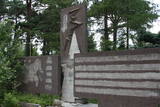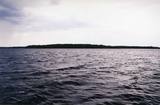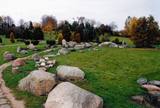| Nr | Name | Beschreibung |
|---|---|---|
|
Atrodas Ostas ielas rietumu galā. No laukakmeņiem veltīto kompozīciju uzstādīja 1938. g. (idejas autors – bijušais Ventspils ostas kapteinis V. Ābelnieks) un tā ir piemiņa visiem zvejniekiem un jūrniekiem, kuriem atdusas vieta ir jūras dzelme. |
||
|
Atrodas 2,5 km no Bārtas centra, Bārtas upes labajā krastā. Mūsdienīgais dievnams tapis 2002. gadā (arhitekte: A. Siliņa). |
||
|
Leuchtturm von Akmeņrags wurde auch in der Zeit der Sowjetunion für die Gewährleistung der Meeresnavigation genutzt. Zur Zeit befindet sich der Leuchtturm im Besitz von Meeresadministration Lettlands und ist für Interessenten nur von Außenseite zugänglich.
|
||
|
Diese Konditorei befindet sich auf der Hauptfußgängerstraße der Stadt. Hier werden Hochzeitstorten nach den Rezepten der Großmütter gebacken, sowie verschiedene Konditoreiwaren hergestellt. Die Konditorei arbeitet mit lokalen Produzenten zusammen. Lettische Küche: Kalte Suppe, Suppe mit Fleischbällchen, Hochzeitstorten aus Haselnüssen-Preiselbeeren und aus Erdbeeren-Rhabarbern, Piroggen, Blechkuchen u.a. Leckereien. |
||
|
Lēdurgas dendroparks ir viens no bagātākajiem parkiem Latvijā. Parkā var iepazīt vairāk kā 1000 koku un krūmu sugas, pasugas un varietātes. Gadu gaitā Lēdurgas dendroparks kļuvis par dabas un kultūrvēsturisku aizsargājamu objektu. Piedāvājumā - skuju un lapu koki, dekoratīvie un ogu krūmi, vīteņaugi, ziemcietes, tējas augi u.c. |
||
|
Die Abteilung der Grenzwache aus der sowjetischen Zeit in Ventspils mit einem fundamentalen Gebäudekomplex, Komplex der Plätze und verschiedener Objekte, die Zur Zeit (außer manche Gebäude) verlassen und nicht bewacht sind.
|
||
|
Das ist Lettlands ältestes Naturreservat und, in der Tat, das älteste geschützte Gebiet des Landes. Moriscala ist eine Insel im See Usma, der der fünftgrößte See in Lettland ist. Das Reservat wurde 1912 auf Initiative einer Gruppe von Naturstudenten von Riga begründet. Sie wollten den Eichenlaubwald auf der Insel schützen und zugleich die örtliche Flora und Fauna. Das Naturreservat schließt auch die Insel Lielalksnīte ein. Besuche des Reservats sind jedoch streng verboten.
|
||
|
Klusā lauku teritorijā un priežu jaunaudzes ielokā atrodas ģimenes uzņēmums ar videi draudzīgu saimniekošanas filozofiju - "LavenderVilla". Teritorijā ir izveidots lavandas lauks un lavandas labirints ar ~ 6000 lavandas stādiem. Saimniecības apmeklētājiem tiek piedāvāts iepazīties ar lavandas audzēšanu, ko izmanto dizaina priekšmetu, ēteriskās eļļas un tējas ražošanai. Papildus tiek piedāvāti naktsmītnes pakalpojumi lavandas un zāļu atpūtas namiņā, pasākumu organizēšana (joga līdzās lavandām, tematiskie pasākumi, kāzu ceremoniju vieta u.c.), pirtnieka pakalpojumi, fotografēšanās iespējas lavandas laukā un lavandas pārtikas produktu degustācijas. |
||
|
Grūti iedomāties, ka vēl joprojām Eiropā ir apdzīvotas vietas, kuru sasniegšanai ir labu laika sprīdi jābrauc pa neapdzīvotu mežu ieskautu smilšainu ceļu, kur tikai paretam var redzēt kādu sēņotāju vai ogotāju! Tāpat kā Zervinos ciemam, arī šim ir piešķirts kultūras mantojuma pieminekļa statuss, jo Linežeris ir viens no dažiem nacionālā parka etnogrāfiskajiem ciemiem. Linežerī ir aplūkojamas 19. – 20. gs. mijā celtās ēkas un apskatāms tā laika ciema plānojums. Šejieniešu tāpat kā citu dzūku galvenā nodarbošanās bija mežistrāde un meža velšu vākšana. Nelielā mērā – arī lauksaimniecība. Apceļojot nacionālā parka etnogrāfiskos ciemus, rodas pamatots jautājums: „Ar ko mūsdienās te nodarbojas cilvēki. Kā viņi spēj dzīvot tik nomaļā vietā”? Jāatzīst, ka lielākā daļa te ierodas tikai vasaras laikā. Neskatoties uz to, etnogrāfiskie ciemi ir ļoti sakopti un joprojām „dzīvi”! |
||
|
Der „Hof der lauten Stille“ befindet sich am Hang zum Ufer eines Altarms des Nevėžys. Hier werden „glückliche Nahrungsmittel“ hergestellt, ausschließlich aus dem, was auf dem eigenen Hof erzeugt wird. |
||
|
Saimniecībā tiek audzētas gaļas šķirnes (Suffolkas) aitas un piena šķirnes (Ostfrīzijas) aitas. Ganāpmulka aizsardzībai saimniecībā strādā ar sargsuņiem, Pireneju kalnu suņiem, kas ir pasaulē arī plaši pazīstama suņu šķirne mājlopu un mājputnu apsargāšanai no lielākiem un mazākiem plēsējiem. Saimnieki piedāvā iegādāties premium klases, saimniecībā audzētu, jēru gaļu un aitu piena produktus- Fetas tipa sieru, grilsieru, jogurtu bez piedevām un vairāku veidu saldējumus. |
||
|
Gemütliches Café im Zentrum von Liepaja. Kaffee, leckere Kuchen, ausgezeichnetes Essen. Jeden Morgen gegen fünf Uhr beginnt der Croissant-Meister mit der Arbeit, damit es um circa neun Uhr frische Croissants gibt. |
||
|
2003.gada decembrī folkloras kopa „Atštaukas” izveidoja folkloras centru „Namīns”, kurā svin svētkus, organizē Jāņu ielīgošanu, Lieldienu iešūpošanu, Miķeļdienas tirgu, Annas dienas Saimnieču svētkus, tautiskos Ziemassvētkus. „Atštaukas” palīdz saglabāt un popularizēt dažādus latviešu tautas godību rituālus, gan kāzu, gan arī bēru tradīcijas. Folkloras centrā „Namīns” darbojas arī skola, kurā bērniem tiek mācīta folklora un tautas tradīcijas. |
||
|
The cafe is situated in Jekabpils, in the shopping centre Aura, on the left bank of the river Daugava. The premises are comfortable and have a touch of a countryside, which can be felt in the wooden interior of the place. They offer breakfast, dinner or supper here. Working hours: 9:00 – 20:00 |
||
|
The terrain in this territory was created during the Ice Age. There are the ancient river valleys of the Minija, Salantas and Erla rivers, along with groups of rocks.
|
||
|
Liela meža masīva vidū gleznainās Būkas (Būka) upes krastos starp kokiem ieslēpies teiksmainais Vaišnoriškes ciems. Šis ir viens no skaistākajiem nacionālā parka etnogrāfiskajiem ciemiem. Vaišnoriške kā apdzīvota vieta sākusi veidoties 1756. g., kad šeit sena vēsturiska ceļa malā darbojies krogs. Pirmā viensēta ciematā ir zināma no 1830. g. Šodien redzamā apbūve ir tapusi g.k. 20. gs. sākumā. Ciems ir palicis cilvēku atmiņās ar liepu medu, jo meža velšu vākšana un biškopība bija viena no galvenajām šejieniešu nodarbēm. Tagad ciemā ir piecas sētas. No Vaišnoriškes var uzsākt laivu braucienu pa seklo un dzidro Būku. |
||
|
Pajumäe ist ein kleiner, netter biologischer Betrieb, der sich im grünen Mulgimaa befindet und verschiedene Milchprodukte herstellt. Sie könne alle Schritte der Milcherzeugung anschauen – von den Kühen auf den Weiden bis zur Verarbeitung in der Molkerei. |
||
|
Auf der Küste der Halbinsel befinden sich sowohl ehemalige Fischerdörfer, als auch die Reste eines Militärstützpunkts der Sowjetarmee. Großartige von den Gletschern des Eiszeitalters eingebrachte Feldsteine. |
||
|
Kurse mit dem Thema „Freundliche Fleischrinder – nicht nur Nahrung sondern auch Freude beim Umgang“ werden angeboten. Dabei können die Besucher sich aus der Nähe mit den Rindern bekannt machen, viel Wissenswertes über deren Zucht und den Nutzen für Dorf und Natur erfahren. |
||
|
Diese Route ist für aktive Fußgänger angemessen, denen es gefällt, Beobachtungen in der Natur mit der Erkundung der Kultur und Geschichte zu verbinden. Diese Route ist eine Reise in den Urstromtal des eindrucksvollsten Flusses der baltischen Länder – Gauja und in den tiefen Urstromtal seines Nebenflusses – Amata. An den Ufern der beiden Flüsse erheben sich landschaftliche Sandsteinfelsen der Devonperiode. Die Siedlung der Papierfabrik von Līgatne ist mit ihrem einzigartigen Dorfmilieu der Papierfabrik aus dem 19. – 20. Jh. ein ausgezeichnetes Beispiel des industriellen Erbes auch in Europa. Am Ende der Route kann man die mittelalterliche Burg von Cēsis – die größte Festung des mittelalterlichen Livlandes – besichtigen. Route information from Latvijas Lauku forums |
||























